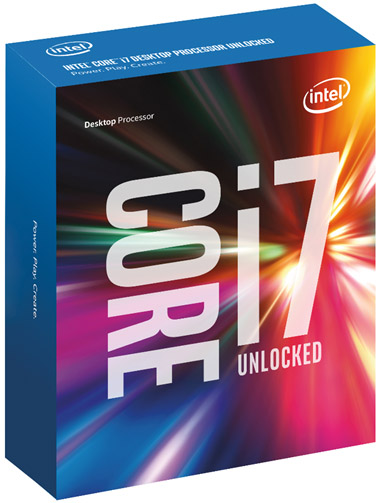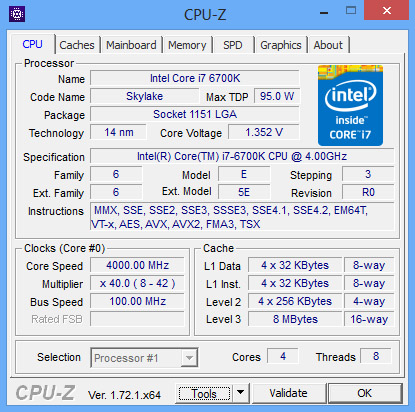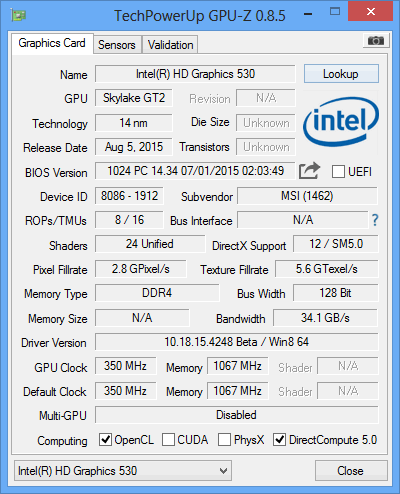Skylake: Intel's Core i7-6700K And i5-6600K
Intel gave us an early look at the Core i7-6700K, i5-6600K and Z170 chipset two weeks ahead of IDF and the unveiling of Skylake's architectural details.
Introduction
It seems like only yesterday that we were introducing you to Intel’s Core i7-5775C and i5-5675C, the first socketed CPUs based on the company’s Broadwell design. In reality, that was about 60 days ago. So why on earth are we talking about Skylake, another new architecture, two months later? Aren’t these big reveals supposed to happen once every couple of years?
It’s no secret that Broadwell encountered delays. We should have been looking at products built on the 14nm die shrink a long time ago. But desktop enthusiasts were among the last in line to get their hands on Intel’s efforts. Perhaps in anticipation of today’s launch, Broadwell didn’t receive much fanfare during Computex 2015. Those C-series parts aren’t even readily available online today. Nevertheless, we marveled at the performance of their graphics engines, sporting 48 EUs and 128MB of embedded DRAM. It was great to also see them arrive multiplier-unlocked, ripe for the affections of power users building highly-integrated HTPCs. The only bummer was that a dialed-back TDP and lower stock clock rates meant Core i7-5775C was slower through our benchmark suite than the previous generation’s Core i7-4790K.
Today we’re pulling the wraps off of the true Devil’s Canyon successors, Core i7-6700K and Core i5-6600K. Our exploration is going to feel a little incomplete though, because Intel isn’t going into detail on the Skylake architecture until IDF later this month. What we have, then, are a couple of CPUs, motherboards based on the Z170 chipset, some killer DDR4 memory kits and a bunch of questions about what makes Skylake special.
It’s almost like someone at Intel decided, “Hey, enthusiasts are going to be so excited to see sixth-gen Core processors at gamescom that they won’t care what’s inside of them.” And you know what? I’m tired of trying to figure out how decisions like these are made. Assume the "better together with Windows 10" angle had something to do with it. So let’s just roll with the information we do have. It’s so much less frustrating that way.
Intel Core i7-6700K And Core i5-6600K CPUs
Tools like CPU-Z with preliminary Skylake support still identify Core i7-6700K as a 95W part. In fact, all of Intel’s early documentation carves out a 95W category. But Intel now says the -6700 and Core i5-6600K have 91W TDPs. They fit into LGA 1151 interfaces keyed differently than its LGA 1150 CPUs, so there’s no way to drop one into an incompatible motherboard. Not that this should be a problem. Because Skylake is architecturally dissimilar from prior Core designs, it requires new core logic. In other words, Core i7-6700K and i5-6600K necessitate platform upgrades, too. Fortunately, Intel isn’t slapping a big premium on either processor. Core i7-6700K should be priced around $350, while Core i5-6600K is expected to sell for $243.
Both CPUs feature four IA cores—we know that much for sure. Like so many line-ups before, the i7 comes equipped with Hyper-Threading. It leverages the power of simultaneous multi-threading to more thoroughly utilize available resources. To Windows, each of the Core i7’s physical cores appears as two logical processors. The Core i5 doesn’t have this feature; its four cores work on four threads.
We’ve also seen these cache configurations before. The higher-end i7-6700K includes 8MB of last-level cache, while the i5-6600K sports 6MB. If CPU-Z is to be believed, Intel’s Skylake architecture continues to arm each core with 256KB of L2 cache, along with 32KB of L1 data and 32KB of L1 instruction cache. Neither the i7-6700K nor the i5-6600K include embedded DRAM, which we saw on the Core i7-5775C and i5-5675C.
Get Tom's Hardware's best news and in-depth reviews, straight to your inbox.
The Core i7-6700K’s base clock rate is a nice, even 4GHz. Its Turbo Boost profile is quite conservative, though. With just a single core active, the -6700K only pushes up to 4.2GHz. Meanwhile, Core i5-6600K starts at 3.5GHz and stretches as high as 3.9GHz. We’ll go into more depth on overclocking shortly, but of the samples we have in the lab currently, -6700K seems comfortable up to around 4.7GHz. We also spent time at 4.9 and then 4.8GHz, but couldn’t get either stable enough under prolonged stress tests. Five gigahertz wouldn’t boot completely.
Intel’s Haswell-E-based Core i7s already incorporate quad-channel DDR4 memory subsystems. However, Skylake promises to make the technology more mainstream with its own dual-channel controller. In actuality, the architecture officially supports DDR4 at data rates as high as 2133 MT/s and DDR3L at up to 1600 MT/s. All of the boards in our lab currently are DDR4-only though, so anticipate needing a new motherboard and memory kit if you step up to one of the two new enthusiast SKUs.
Most enthusiasts probably won't care, but Intel’s Skylake-based K-series SKUs come armed with the graphics configuration referred to as GT2. The company seems to be saving all of its graphics fanfare for IDF, which is understandable when that’s not a meaningful part of today's conversation. What this means, though, is that the impressive gains we saw from Broadwell’s GT3e arrangement are gone. Those 48 EUs become 24 in Skylake’s middle-of-the-road implementation, branded as HD Graphics 530, and they operate at up to 1150MHz.
Notably, the Gen9 engine implemented in Skylake does support DirectX 12, OpenCL 2.0, OpenGL 4.4 and OpenGL ES compared to Gen8’s DirectX 11.1 and OpenCL 1.2. When the engineers do start talking about graphics at IDF, expect them to spend a lot of time on architectural optimizations targeting power. Of course, performance is tuned as well, primarily through better utilization of available bandwidth (hierarchical Z and memory color stream compression). Through its Y-, U-, H- and S-line platforms, Gen9 should touch everything from 4W to these 91W parts. There’s much more to discuss on the display side (GT4e should be amazing), but we’ll save what we know for another day.
Both Skylake-based processors feature 16 lanes of PCIe 3.0 connectivity for add-in cards, just like their predecessors, configurable as 1x16, 2x8 or 1x8/2x4 links. Where they differ, however, is the four lanes that Intel sets aside for attaching a Platform Controller Hub. In generations past, the company called this interface DMI 2.0. It offered up to 2GB/s of bi-directional throughput—enough to accommodate most combinations of mainstream storage, peripherals and networking. But the 100-series chipsets are more feature-rich, necessitating greater bandwidth to the host processor. As such, Intel gives Core i7-6700K and Core i5-6600K a Direct Media Interface 3.0 theoretically capable of moving almost 4GB/s.

Igor Wallossek wrote a wide variety of hardware articles for Tom's Hardware, with a strong focus on technical analysis and in-depth reviews. His contributions have spanned a broad spectrum of PC components, including GPUs, CPUs, workstations, and PC builds. His insightful articles provide readers with detailed knowledge to make informed decisions in the ever-evolving tech landscape
-
rantoc Yawn... its easy to see that intel have to little competition, they have stagnated in the cpu performance department!Reply -
Vlad Rose What the heck Intel? So, you provide great integrated graphics into Broadwell, then nerf it for Skylake? I guess you had to find a way to help sell your 'paper launch' of Broadwell. I really hope Xen makes you guys wake up; although it more than likely won't.Reply -
Bartendalot At least Skylake HEDT should be powerful. Unless DX12 pulls a rabbit out of a hat, this doesn't look promising for anyone who has Sandy or higher.Reply -
stairmand ReplyStill 4 cores.... Im sticking to my Q6600.
Then you really are missing out, 4 cores or not a current i5 (let alone an i7) will simply destroy the old Q6600 C2Q. It was great in the day but it's very old hat now and the lack of features on the board worse still. -
salgado18 ReplyStill 4 cores.... Im sticking to my Q6600.
You do know that your Q6600 is astronomically slower than Skylake in every single department, right? By your logic, the Phenom II X6 is better than the i7 6700K.
I think you should consider upgrading. You won't regret, promise. -
salgado18 ReplyWhat the heck Intel? So, you provide great integrated graphics into Broadwell, then nerf it for Skylake? I guess you had to find a way to help sell your 'paper launch' of Broadwell. I really hope Xen makes you guys wake up; although it more than likely won't.
Do you mean Shen, from LoL? Or Zen? XD
I believe the cost of the integrated memory chips would make these processors too expensive and niche to be viable products.
-
Lmah Good upgrade for 1st Gen i5/i7 users. Though I think they targeted it at the 2nd Gen i5/i7 users, doesn't seem like a huge improvement for them though.Reply


